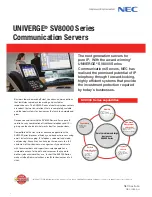
This is a mechanism for routers to convey routing information back to the
server. When one router detects that another router offers a better route to a
destination, it sends the server a redirect that temporarily overrides the
server’s routing table. Being router-based, dynamic redirects do not require
any configuration, but they can be viewed in the routing table.
The server stores dynamic host routes in its routing table for up to 10
minutes. When a dynamic host route expires, it is removed from the routing
table. When subsequent packets are sent to the selected destination, the
choice of gateway is determined by the remaining routes in the routing table
until the server receives another ICMP redirect. The server creates a dynamic
host route for each redirect received. The host route cache can store up to
65,000 dynamic routes at a time.
ICMP router discovery
The NAS server supports ICMP router discovery, which enables it to discover
the addresses of routers. ICMP routers periodically multicast their addresses;
when the server receives these multicasts, it incorporates the routers into its
routing table.
ICMP router discovery is controlled using the CLI command
irdp
. For more
information, see the
Command Line Reference
. A router learned using IRDP
is propagated to the routing table as a default gateway.
The NAS server discovers IPv6 default gateways through ICMPv6 router
advertisements.
RIP (v1 and v2)
This is an industry standard, enabling servers to automatically discover
routes and then update routes in the route table based on updates provided
by other network devices. RIP (v1 and v2) is controlled using the CLI
command
rip
. For more information, refer to the
Command Line Reference
.
Managing routes
The HNAS server selects the
most specific
route available for outgoing IP
packets. The
host route
is the
most specific
, as it targets a specific computer
on the network. The
network route
is the next most specific, as it targets a
specific network. A
gateway
is the least specific route, which provides a third
routing option for the server. Therefore, if a server finds a host route for an
outgoing IP packet, it selects that route over a network route or gateway.
Similarly, when a host route is not available, the server selects a
corresponding network route or, in the absence of host and network routes,
the server sends the packet to a default gateway.
28
Routing overview
Hitachi NAS Platform Network Administration Guide
Содержание 3100
Страница 1: ...Hitachi NAS Platform Network Administration Guide Release 12 5 MK 92HNAS008 08 December 2015 ...
Страница 5: ...5 Hitachi NAS Platform Network Administration Guide ...
Страница 9: ...9 Hitachi NAS Platform Network Administration Guide ...
Страница 13: ...Preface 13 Hitachi NAS Platform Network Administration Guide ...
Страница 57: ...Configuring routes 57 Hitachi NAS Platform Network Administration Guide ...
Страница 73: ...Managing networks and devices 73 Hitachi NAS Platform Network Administration Guide ...
Страница 87: ...Network ports 87 Hitachi NAS Platform Network Administration Guide ...
Страница 88: ...Hitachi NAS Platform Network Administration Guide ...
















































